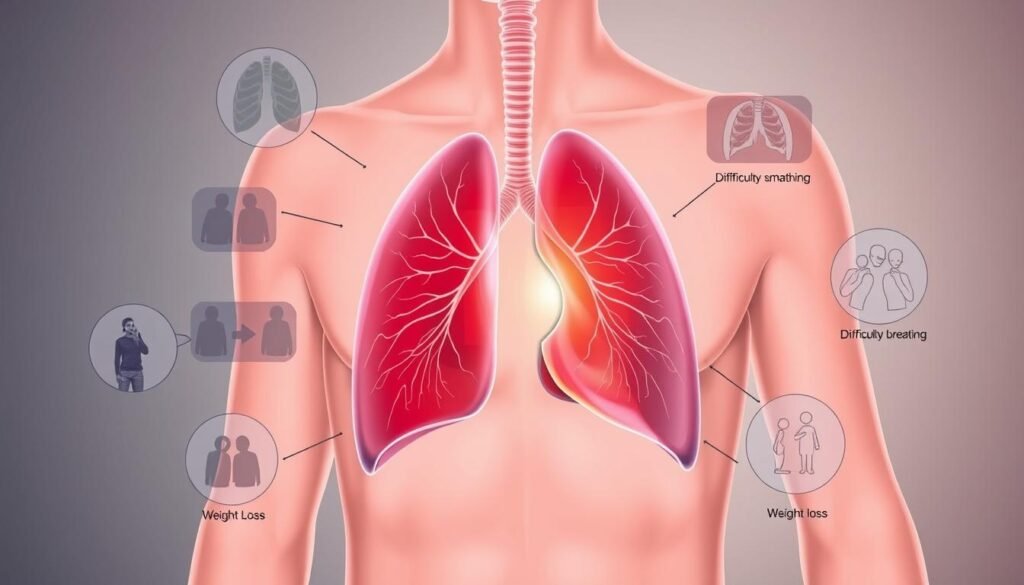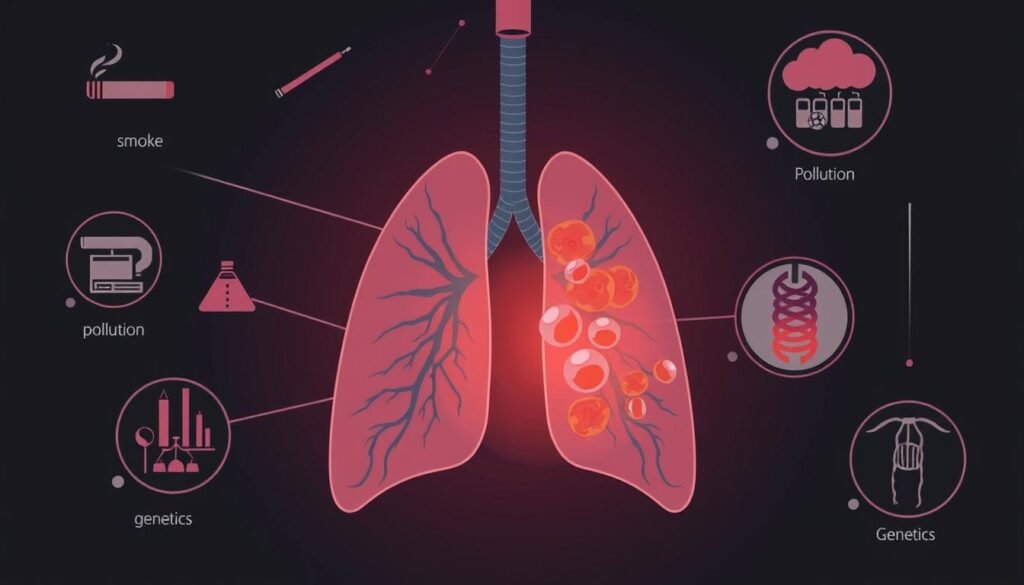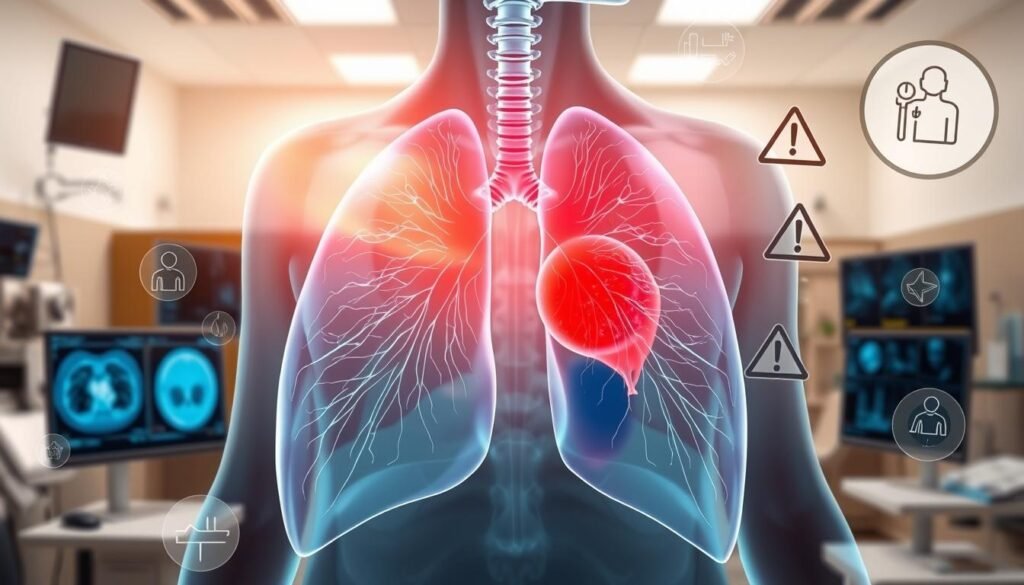Lung cancers often don’t show symptoms until they’ve spread. This makes knowing the early signs very important. For those with right lower lobe lung cancer, noticing symptoms soon can really help with treatment. Symptoms like constant coughing, pain in the chest, and feeling short of breath are key warning signs.
Catching these signs early and understanding them means you can get help faster. This can make treatment work better. This article will help readers spot these important symptoms. It explains why finding them early is key in battling lung cancer.
Key Takeaways
- Many lung cancers remain asymptomatic until they advance, underscoring the importance of vigilance.
- Early detection of lung cancer often correlates with more effective treatment outcomes.
- Persistent cough and chest pain are among the critical warning signs of right lower lobe lung cancer.
- Shortness of breath should prompt immediate medical evaluation to rule out lung cancer.
- Awareness of symptoms can significantly influence the timing and success of treatment options.
Overview of Lung Cancer
Lung cancer is the top killer among all cancers globally, showing its harsh effects on health. Getting to know the lung cancer overview helps us grasp how common this disease is. It starts in the cells of the lungs and appears in different forms. The main kinds of lung cancer types are non-small cell and small cell lung cancer. While heavy smokers often get small cell lung cancer, non-small cell lung cancer can affect anyone.
Many factors raise the risk of lung cancer. The top cause is smoking. The more you smoke, the higher your risk. Secondhand smoke also increases the risk for those who don’t smoke. If your family has a history of lung cancer, your risk is higher too. Being exposed to harmful substances like asbestos and nickel at work can also raise your risk.
Knowing these lung cancer facts is key in spotting those at high risk. This knowledge helps in taking steps to prevent it and finding it early. With new treatments from surgery to targeted therapy, understanding lung cancer is vital. This is true for both patients and their doctors.
The Importance of Early Detection
Discovering lung cancer early is crucial for better treatment results and living longer. About 1.3 million people die each year from it worldwide. It’s important to notice early signs. This is because by the time symptoms show, the cancer is often advanced. That’s why regular checks are key for people at high risk.
Joining screening programs offers big benefits, especially for lung cancer outcomes. Though lung cancer’s overall five-year survival rate is below 15%, catching it early can greatly improve chances. In early stages, people with non-small cell lung cancer (NSCLC) can have a survival rate above 65%. If the lesions are very small, this rate can jump over 80%.
But, screening for lung cancer isn’t perfect. Early detection helps many, but it’s not a sure win for everyone. Issues like lead-time bias complicate the picture. This means even if survival time looks better, it might not actually mean better health overall.
Seeing your doctor regularly and getting into lung cancer screening programs is key. Especially, low-dose CT scans can pinpoint problems early on. For those at risk, knowing about these options is crucial. Being aware of how early detection works can lead to early help and better health results.
Common Symptoms of Lung Cancer
Lung cancer is hard to notice until it’s quite advanced. Knowing the common symptoms of lung cancer is key. One early sign can be a persistent lung cancer cough that doesn’t go away. Over time, this cough may get worse and sometimes bring up blood.
Chest pain can be another important clue. It often happens with laughter, deep breaths, or exercise. Shortness of breath and wheezing might also happen, showing possible airway blockages. People might feel lung cancer pain too. This can be an ache in the chest or back unrelated to other issues.
- Hoarseness
- Unexplained weight loss
- Loss of appetite
- Frequent respiratory infections
If you know these symptoms, you can get help sooner. If you have symptoms that worry you, see a doctor. This is especially true for those who smoke or have lung cancer in their family. Early checks can really help. Learn more about spotting symptoms here.
Right Lower Lobe Lung Cancer Symptoms
It’s key to know the symptoms of right lower lobe lung cancer for early help. People may feel different symptoms, from mild to bad. Spotting these signs early can help start treatment sooner.
Coughing Up Blood
About 15 to 30 percent of those with lung cancer cough up blood. This scary sign means there might be tumors or other issues in the lungs. If you cough up blood, see a doctor right away to find out why.
Chest Pain
Many dealing with this type of lung cancer have chest pain. This pain can come from the tumor pushing on nearby parts. Or from too much fluid in the chest. Knowing this can help you talk about your symptoms with a doctor.
Shortness of Breath
Nearly half the people with lung cancer feel short of breath. This happens when tumors block airways or the lungs don’t work well. If you’re short of breath, it might mean the cancer is advanced. For info on these signs, check out trusted sources.

| Symptom | Occurrence Percentage |
|---|---|
| Coughing Up Blood | 15-30% |
| Chest Pain | Varies (Common) |
| Shortness of Breath | 45% |
| Cough | 50-75% |
Knowing the symptoms of right lower lobe lung cancer raises awareness and helps in early detection. For more about other signs of lung cancer, go to this link.
Additional Warning Signs to Watch For
It’s key to know not just the main symptoms of lung cancer. Spotting other signs is vital, especially for people at higher risk. These signs can give important clues that something might be wrong.
Unexplained Weight Loss
When people lose weight without trying, it could mean trouble. This is true for lung cancer among other health concerns. If your weight drops suddenly, see a doctor. This is crucial if you’re also seeing other odd symptoms.
Fatigue and Loss of Appetite
Feeling tired all the time? Does nothing sound good to eat? These could be signs of lung cancer that need a doctor’s look. Catching these signs early can make a big difference in getting better.
Recurring Lung Infections
If you’re often sick with lung issues like bronchitis or pneumonia, pay attention. These could be more than just bad luck. They might be signs of lung cancer. Talking to a doctor about these recurring problems is a smart move.
Understanding the Causes and Risks
Lung cancer comes from changes in lung cells’ genes. Many things play a part in this. Smoking is a big cause, linked to up to 90% of lung cancer cases. People who smoke are much more likely to get lung cancer. The more and longer people smoke, the bigger the risk.
Being around smoke from others, air pollution, and dangerous substances like radon gas and asbestos also increase lung cancer risk. If lung cancer runs in a family, the risk goes up too. Being exposed to these things for a long time makes lung cancer more likely.
To show how different causes relate to higher risks, see this table:
| Risk Factor | Impact on Lung Cancer Risk |
|---|---|
| Smoking | Accounts for 90% of cases; increases risk by 15-30 times |
| Secondhand Smoke | Responsible for approx. 3,000 deaths annually in the U.S. |
| Radon Exposure | Causes about 21,000 deaths yearly; 12% of lung cancer deaths |
| Asbestos Exposure | Increases risk nine times, 50 times when combined with smoking |
| Family History | Increases likelihood of developing lung cancer |
Knowing about lung cancer causes and risks helps people make better choices. It encourages them to get advice from doctors if they spot symptoms that worry them. Spotting signs early is key. For details on early warnings, go to this link.

When to See a Doctor
Knowing when to see a doctor for lung cancer is very important. If you have a chronic cough, chest pain, or unexplained weight loss, you should seek help right away. These symptoms could be signs of lung cancer and need a doctor’s attention.
Getting checked early can make a big difference in treatment. It’s especially important for those who’ve smoked a lot, have lung cancer in their family, or been around harmful substances. If you’re having trouble breathing or keep getting lung infections, tell your doctor.
Being aware of your health and any strange changes is key. This can mean catching lung cancer early, when it’s more treatable. For detailed information on lung cancer symptoms, see this comprehensive guide.
Diagnosis and Testing for Lung Cancer
The first step in diagnosing lung cancer begins with imaging for lung cancer. A chest X-ray is often the starting point. Most lung tumors show up on X-rays as white-gray masses. But, chest X-rays can’t always tell lung cancer apart from other issues like abscesses.
After the X-ray, a CT scan is usually next. It uses X-rays and contrast to make detailed images. It takes 10 to 30 minutes. Then, a PET-CT scan might be done to find active cancer cells. This scan is key for planning treatment. It lasts between 30 to 60 minutes.
A bronchoscopy may be done to check the lungs, especially for central chest cancers. It can feel uncomfortable and takes about 30 to 40 minutes. An EBUS, or ultrasound with bronchoscopy, helps get a better biopsy. This method takes around 90 minutes.
Biopsies confirm lung cancer tests. They can be done in different ways, like thoracoscopy. Some methods need you to stay in the hospital briefly. Rarely, complications like a collapsed lung might happen. If they do, special care is needed.
Lung cancer is staged using the TNM system. It looks at tumor size, lymph node involvement, and metastasis. Non-small-cell lung cancer stages include four T stages, three N stages, and two M stages. Small-cell lung cancer is either limited or extensive disease. Detailed testing is crucial to create the right treatment plan.

Treatment Options for Lung Cancer
Lung cancer treatments vary, depending on the disease’s type and stage. Surgical options are important for early-stage lung cancer. These can include removing parts of the lung or the entire lung. Such surgeries aim to cure localized cancers.
Chemotherapy is key, especially for advanced lung cancer. It can shrink tumors before surgery or kill remaining cancer cells after. These drugs target cancer cells all over the body. They are a common choice for treating lung cancer.
Radiation therapy targets cancer in specific areas. It’s a non-invasive method used for symptom control or as part of a treatment plan. Targeted therapy is another option. It attacks the cancer’s unique traits, adding precision to treatment plans.
Immunotherapy is a new approach. It boosts the immune system to fight cancer. Drugs like pembrolizumab and nivolumab show promise for some patients. They may improve survival rates in certain cases.
Palliative care is crucial for advanced cancer. It helps manage pain and discomfort. This care supports patients through their treatment.
Research is bringing new treatment options for lung cancer. For details on therapies, visit current strategies for treating lung cancer. Knowing the available approaches helps patients and families make informed choices.
| Treatment Type | Description | Indication |
|---|---|---|
| Surgery | Removal of tumor and affected lung tissue | Early-stage lung cancer |
| Chemotherapy | Drug treatment that targets cancer throughout the body | Various stages, often post-surgery |
| Radiation Therapy | Non-invasive treatment that targets cancer cells | Palliative care and localized control |
| Targeted Therapy | Drugs that target specific characteristics of cancer cells | Specific types of non-small cell lung cancer |
| Immunotherapy | Activates the immune system to fight cancer | Certain non-small cell lung cancers |
Conclusion
Knowing the symptoms and warning signs of right lower lobe lung cancer is key to early action. Understanding these early signs can greatly affect a patient’s chance of getting better. It’s important to see a doctor if you have concerning symptoms.
Lung cancer awareness is vital for prevention. Every year, more than 43,000 people in the UK find out they have lung cancer. Education and staying informed are necessary to lower these numbers. Talking about lung health is important.
The battle against lung cancer relies on awareness and personal health efforts. By learning about lung cancer, people can make informed health choices. This leads to better outcomes for those with the disease. With the right knowledge, we can all help reduce risks and improve our health.